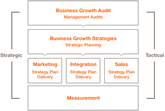
Just what are they doing to beat you? How are they delivering their compelling message? How are they undermining your unique differential? What do they intend to do next? How well are they really performing?
Lots of questions often responded to with anecdotal quotes or gut instinct. No real facts, no real evidence.
Without real competitor intelligence you will always be second in the queue when it comes to creating unique differential and a commanding presence. You should be adopting an approach which looks at your competitors in a series of layers:
Performance fiscally What are they doing to make themselves more flexible in cash terms, to manage difficult market conditions, their overheads and debt ratio’s, the need to manage loans and overdrafts whether short-term or long), the cost of the recruitment and retention, their investments and the proportion of budget spent on R &D, sales and marketing or equity surplus.
Performance by productTheir ability to create new lines, sustain old and protect long-term cash generative revenue streams from others. Their investment approach and the technology or methodology they apply in creating or sustaining existing product lines.
Performance by sales and marketingThe more visible actions will be easy to monitor, their invest in above the line marketing and its frequency. But what about measurement of its effectiveness? How are they engaging at sales point? What about the issues of customer management and account penetration. All these should be measured if you are to get a real picture of the sales and marketing effort.
You should be considering customers, their retention and the profit to sales ratio… The list of intelligence layers is deep. But so is the responsibility to stay ahead of the competition – not play lip service to it. Your employees depend upon this, your customers thrive on it and any equity partners expect it.
Creation Of The Competitive Intelligence Framework
Documented profile of the ‘perceived competition’ and the reasons why these are the competition. Creation of the Prime A competitor. Determination of what makes a Prime A competitor and how effective such an adversary would be in closer timescales or market erosion.
Development of Competitive Universe
Documentation for a region (based upon scope, terms of reference) of competitive organisations that are deemed likely competitors, ranging from Prime A ‘Revenue Killers’ through to Prime D ‘ Mis-informers’. To consider who the competition are and why. To segment into direct, indirect and substitutional efforts or competitive forces. To map out their distribution curve and the effectiveness within a performance index (individually and across each of their subsidiaries or branches).
Analysis Of The Competitive Universe Targeting
Documentation and assessment; as part of the affectivity index; their direct target audience and the overlay, consider indirect and those audiences their branding or peripheral marketing affects and creates some form of awareness. For this later section, establish what this awareness is.
Universal Snap-shot Weakness Analysis
Holistic representation of the competitive universe weaknesses and order of magnitude.
Creation Of The Universal Product & Service Map
Determination Of The Universal Market Penetration Profile & Profit Contribution
Prime A (Key Competitor) Organogram Analysis
A business study of the management approach, key members and the associated relationships of the management team in relation to day-to-day performance and key milestone changes.
Prime A Business Review
A comprehensive assessment and reporting of business performance, key limitations in finances, investment approaches and their core revenue streams (including their sustainability long-term), working capital assessment and vulnerabilities noted through extended loans or shareholder equity plans.. This analysis may be extended to in line with the Prime A Organogram Analysis to assess decision making approaches, noted or perceived (industry and specific) weakness on the management team or Board and their efforts to create, manage or document visionary thinking within the management team structure.
Prime A Thought Leadership Assessment
Documentation of any form of visionary concept that is driving company and development, culture and investment efforts. Analysis of this concept and any supporting methodology that may enable this concept to come into fruition. Consideration of any unique differentials this under pins and the USP that is applied to product, service, people, culture and the brand.
Prime A Skills Assessment
A comprehensive study of individuals employed within the Prime A competitor, their limitations and their potential. This is to be considered from the Board downwards and include their investment in training and also their culture.
Prime A Breadth & Dept Analysis
A consideration of the competitor’s ability to change to business and market trends. How these are being interpreted from the Board to the product development or marketing levels and how their products and services may move into new trend cycles without substantial investment or change.
Prime A Product & Service Definition
A direct comparison of product functionality, technology backbone and vision of research and development to determine the direction and investment plans of the competitor’s research and development effort. This will also consider the penetration of their product portfolio and the retention period that a product has at a customer level regardless of version control, the processes that this benefits and the limitations or strengthens it presents directly and indirectly.
Prime A Product Development Partner Analysis
Documentation of all third parties technology, services or skills applied to the product or service portfolio, the value such players bring and the vulnerability such partners causes upon the given product or service should they fail or remove themselves from he relationship.
Prime A Customer Profiling
A comprehensive review of noted customers, their demographic profile, profit contribution and service overhead as well as reasons for acquiring product or services.
Prime A Customer Retention Analysis
Documentation of churn rates and methods to retain customers including service level agreements as well as pricing policy and contractual lock down.
Prime A Assessment Of Sales & Marketing Collateral
An assessment of the collateral impact each function has upon the market, unique selling point exploitation, messages to market and their effectiveness along with their message distribution methods (sales and marketing plans and above the line activities) investments, co-operatives and channel.
Prime A Sales Effectiveness Analysis
A complete overview of the sales performance (revenue and new business tasked) their approach and tactics or methods applied, presentation, negotiation or demonstration technique and use of supporting skills such as presales or key influencers.
Prime A Customer Service Analysis
A comprehensive review (customer side orientation as well as perceived) of customer support, methods to maintain the relationship and its success as well as customer lock in tactics such as use of contractual obligations or specialist support services following tailoring of a product or service.
Prime A Channel Analysis
A detailed summary of channel or indirect routes to market use for sales and support activities, the planning behind such activities (strategy if any) an how relationships are nurtured during partner activities 9including their support, reporting and visibility). This report may be extended to determine the creation of the channel or indirect route, answering such key issues of recruitment policy and strategy, methods of attrition, skills analysis and management of channel conflict.



